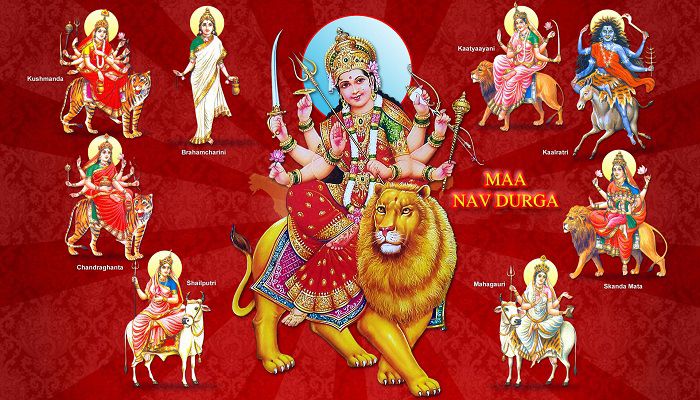The divine goddess is known as Nav Durga which means Nine different forms of mother goddess. These nine forms are representations of different facets of her divinity and various attributes and abilities that she possesses. The goddess Durga is celebrated during the nine night of navaratri the goddess’s victory over the demon Mahishasura.
1. Shailaputri: The Daughter of the Mountains
The goddess is represented by the first form, known as Shailaputri, as the daughter of mountains. Her strength and determination are represented by a depiction of her riding a bull. The worship shows how people value inner strength and unwavering will.
2. Brahmacharini: The Ascetic Goddess
The second form is called Brahmacharini that denotes asceticism and atonement. A picture shows her with a rosary and a water pourer to symbolize control and devoutness. She is asked to bring inner peace and spiritual growth among devotees.
3. Chandraghanta: The Warrior Goddess
The third form is Chandraghanta, fiercer and militant in appearance. A crescent moon is placed on her head and she mounts a tiger which depicts valour and courage. Her worship is supposed to clear away obstacles and pave the way to success.
4. Kushmanda: The Creator of the Universe
The fourth one is Kushmanda the form of the universal’s creation. She normally has several limbs, and it is said that she gave birth to the universe through her divine grin. Kushmanda worship means asking blessings for wealth and affluence..
5. Skandamata: The Divine Mother of Lord Skanda
It is the fifth form – in which Skandmata is the mother of Lord Kartikeya (Skanda). This represents maternal affection as she carries her baby in her laps. People go there so that they can have her blessing on how they should take of their family as per health and financial standpoint.
6. Katyayani: The Warrior Princess
The sixth form called as Katyayani represents courage and steadfastness. A warrior goddess pictured on her chariot, spear in hand, holding arrows, and lions at her feet. Her worship is thought to empower with courage.
7. Kaalratri: The Fierce and Destructive Form
Kaalratri, the seventh form, is a fierce manifestation of Durga. She has a dark complexion and is believed to ward off evil spirits and negative energies. Worshipping Kaalratri represents the removal of darkness and the victory of light.
8. Mahagauri: The Goddess of Purity
Mahagauri, the eighth form, who is famous for her fairness and purity. She is usually dressed in white clothes signified with innocence, calmness, and restfulness. Her devotees crave upon pure heart and body..
9. Siddhidatri: The Giver of Blessings
The ninth and final form is Siddhidatri, the bestower of supernatural powers and blessings. She is often depicted with four arms and is believed to fulfill the desires of her devotees. Worshipping Siddhidatri signifies seeking divine blessings and spiritual growth.
The nine forms of Nav Durga represent the multifaceted nature of the goddess and her various roles in the universe. During Navratri, devotees worship each of these forms on specific days, seeking blessings, protection, and guidance from the divine mother. Nav Durga serves as a reminder of the power, strength, and love that the goddess embodies, and her worship fosters inner transformation and spiritual growth.

